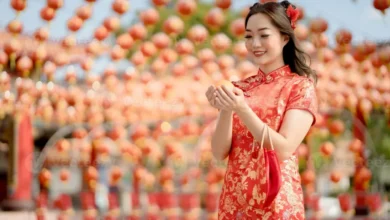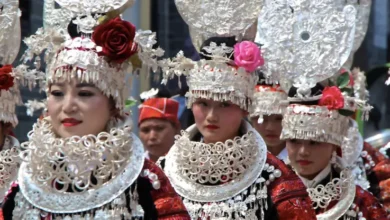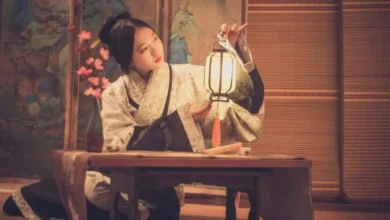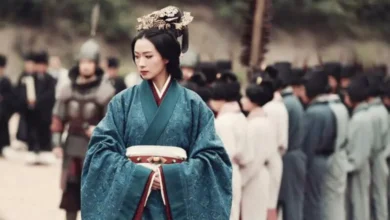A Symbol of Heritage and Modernity
Traditional Chinese clothing has evolved significantly over thousands of years, reflecting the country’s deep-rooted culture, philosophy, and history.
One of the most iconic and influential pieces of traditional attire is the Zhongshan Suit (中山装), often referred to as the Mao suit due to its association with Chairman Mao Zedong. This outfit transcended generations, merging ancient traditions with modern sensibilities, and continues to be a symbol of national identity and pride in China.
In this article, we will delve into the origins, cultural significance, evolution, and the enduring legacy of the Zhongshan Suit. Whether you are a fashion enthusiast, history buff, or curious about Chinese traditions, this guide will provide a comprehensive understanding of this iconic garment.
What Is the Zhongshan Suit?

The Zhongshan Suit, also known as the Mao suit, is a Chinese jacket that became widely popular during the early to mid-20th century. This iconic outfit is characterized by its simple design and functionality. The jacket features a short collar, four pockets, and five buttons—a minimalistic approach that marked a break from the elaborate, highly decorative traditional Chinese attire.
See also The Timeless Elegance of the Dhoti: India’s Traditional Attire
The Timeless Elegance of the Dhoti: India’s Traditional AttireThe suit was named after Sun Yat-sen, the founding father of the Republic of China, who is often referred to as Zhongshan in Chinese. It became symbolic of the Republican era, representing both national pride and social transformation. The Zhongshan Suit gained its most significant prominence in the mid-20th century and became a symbol of China’s revolutionary spirit.
Historical Background: The Origins of the Zhongshan Suit
The Zhongshan Suit emerged during the early 20th century when China was undergoing significant political and social changes. The downfall of the Qing Dynasty in 1911 led to the establishment of the Republic of China.
As the country sought to modernize, the government began pushing for reforms in various aspects of life, including clothing. Traditional Chinese garments, such as the qipao (旗袍) for women and the changshan (长衫) for men, were seen as symbols of the old regime and were no longer viewed as appropriate for a modern nation.

The Influence of Western Fashion
As Western ideas and styles spread across China in the late 19th and early 20th centuries, Chinese society began adopting certain Western fashions, particularly suits worn by European and American men. Sun Yat-sen, who spent time in both Japan and the West, believed that a national dress should symbolize the unity and modernization of the Chinese people. In 1929, he introduced the Zhongshan Suit, designed to be a practical, modern, and distinctly Chinese alternative to Western suits.
See also The Timeless Elegance of the Sherwani: Traditional Indian Clothing
The Timeless Elegance of the Sherwani: Traditional Indian ClothingSun Yat-sen’s Vision
The suit was designed to symbolize the Republican ideals of China, with its simple and utilitarian design representing the break from traditional hierarchical, aristocratic clothing. Sun Yat-sen’s goal was to create a piece of attire that would promote unity, equality, and national pride, helping to unify the Chinese people under a common identity.
Design Features of the Zhongshan Suit
The Zhongshan Suit combines traditional Chinese elements with Western influences, creating a distinct style that set it apart from previous Chinese clothing. Below are some key features of the design that have contributed to its enduring legacy.
1. Simple, Practical, and Elegant
The Zhongshan Suit was designed to be functional and practical, focusing on simplicity over ornate decoration. The short collar (立领) and straight-cut design were functional, allowing for ease of movement. It was a far cry from the extravagant robes worn by Chinese emperors in the past.
2. Five-Button Design
One of the key elements that distinguishes the Zhongshan Suit is its five-button design, which symbolizes the unity of the five major ethnic groups in China—Han, Mongol, Manchu, Tibetan, and Hui.
3. Four Pockets
The suit typically has four pockets (two on the chest and two at the waist), which emphasize practicality and functionality. The pockets made it easy to carry personal items without the need for additional accessories.
4. Fabric and Colors
The Zhongshan Suit is often made from wool, cotton, or tweed, suitable for various weather conditions. The color palette is usually muted, with dark blue, gray, and black being the most common choices. These colors symbolize both modesty and authority.
Cultural Significance of the Zhongshan Suit
The Zhongshan Suit played a pivotal role in shaping the national identity of China during the 20th century. Here’s how it has impacted the culture and history of the nation.
1. A Symbol of Unity
The Zhongshan Suit was more than just a piece of clothing; it became a symbol of the Chinese nation. It represented the new Republic of China, with the five buttons symbolizing unity among the country’s diverse ethnic groups.
2. A Mark of Revolution
The outfit became strongly associated with the Chinese revolution. It was worn by political leaders, including Mao Zedong, during the Chinese Civil War and the People’s Republic of China’s early years. The suit became a powerful symbol of the Communist Party and its efforts to reshape Chinese society.
3. Reflecting National Pride
As China emerged as a major global power, the Zhongshan Suit became synonymous with national pride. It represented the nation’s independence, strength, and cultural heritage.
The Evolution of the Zhongshan Suit
Since its inception, the Zhongshan Suit has gone through several transformations, adapting to changing political and social climates.
1. The Mao Suit
After the founding of the People’s Republic of China in 1949, the Zhongshan Suit became even more entrenched in the country’s political landscape. Under the leadership of Chairman Mao Zedong, the suit became emblematic of revolutionary values. Mao himself was frequently photographed wearing the suit, and it became a common uniform for officials, soldiers, and citizens.
2. The Decline and Revival
With the rise of economic reforms in the late 20th century, Western-style clothing became more prevalent in China, leading to a decline in the popularity of the Zhongshan Suit. However, in recent years, there has been a revival of interest in traditional Chinese clothing, and the Zhongshan Suit has seen a resurgence, especially in political and ceremonial contexts.
How the Zhongshan Suit Differs from Other Traditional Chinese Clothing

While the Zhongshan Suit shares some commonalities with other traditional Chinese clothing such as the qipao or changshan, it is distinct in several key ways.
1. Practicality vs. Ornateness
Unlike the highly ornate and formal qipao, the Zhongshan Suit is designed for practicality. It lacks the embroidery, silk fabrics, and intricate details that characterize much of traditional Chinese clothing.
2. Western Influence
While traditional Chinese attire is often highly influenced by Confucian ideals of hierarchy and symbolism, the Zhongshan Suit incorporates Western elements, such as its straight-cut design and functional pockets, making it more in line with modern, everyday clothing.
The Zhongshan Suit in Modern China
Today, the Zhongshan Suit is rarely worn on a daily basis, but it is still a powerful symbol of Chinese heritage. It is often seen during state functions, official ceremonies, and formal events. Additionally, the suit is still worn by some high-ranking officials as a symbol of respect for tradition.
1. A Symbol of Respect
The Zhongshan Suit is often worn during important anniversaries, memorial events, and political gatherings, serving as a respectful nod to the past.
2. Reviving Tradition
In the 21st century, there is growing interest in reviving traditional Chinese clothing as part of a broader movement to reconnect with the country’s cultural roots. This has led to the reappearance of the Zhongshan Suit in public life, with modern interpretations and updates to suit contemporary tastes.
Final Thoughts: The Enduring Legacy of the Zhongshan Suit
The Zhongshan Suit is far more than a piece of clothing; it is a reflection of China’s journey from the old imperial system to the modern republic. From its revolutionary origins to its status as a symbol of national pride, the suit stands as a testament to China’s complex history and the enduring strength of its cultural heritage.
While its popularity may have waned over the years, the Zhongshan Suit remains a powerful symbol of unity, equality, and national pride. As China continues to evolve, this iconic outfit will undoubtedly remain a part of the nation’s identity for generations to come.




